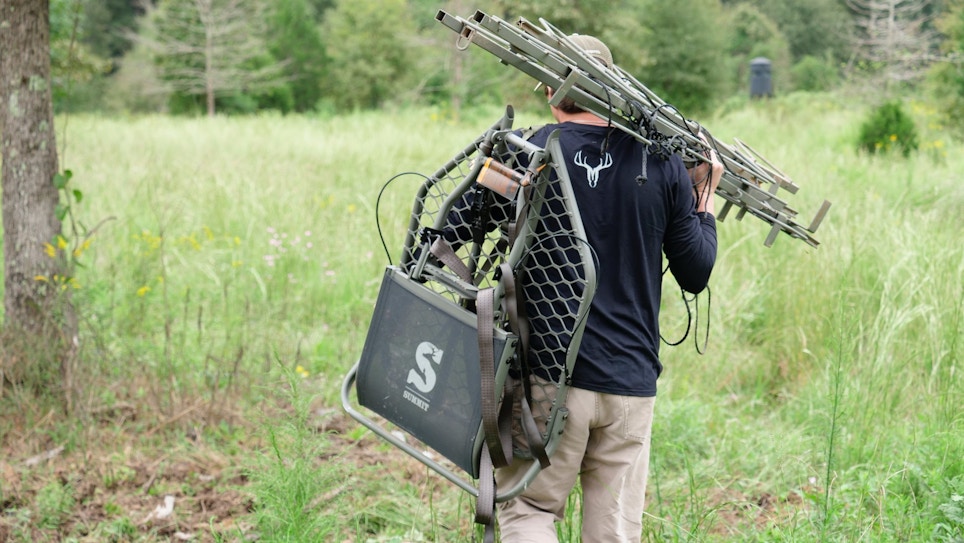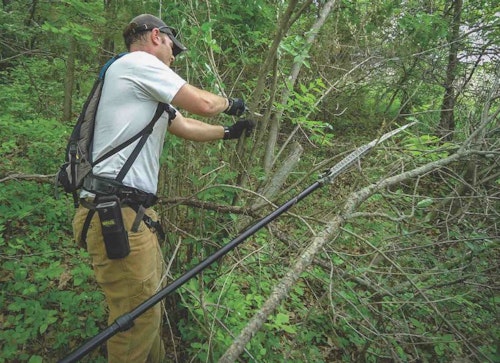
Photo: Southern Attraction Outdoors, Summit Treestands (Facebook)
While growing up on my family’s 9-acre subdivision lot in rural Wisconsin, I spent every possible second roving through the timber and connecting with nature. When I reached hunting age, however, I didn’t bother hunting on our property due to its size. I was too young to realize that our small property could indeed draw deer and provide bowhunting opportunities.
In my late teens, my brother and I created a clearing and then planted a food plot on our family’s property. Unfortunately, we seeded too thick, and the little sprouts competed, then choked out before season. We were pretty upset with the outcome. However, we learned a valuable lesson.
The following spring, my brother was in college, so I planted the clearing alone, taking utmost care not to overplant. And as spring turned to summer and summer to fall, the rape, clover and chicory plot became luscious. My trail camera was capturing deer and turkeys daily. I was stoked.
In October that season, I hunted over the small plot. I saw three deer and took out a mature doe. I’d done exactly what I’d watched the big shots do on outdoor TV. I worked. I planted. I hung. I killed. And it felt awesome!
Even more impressive, I captured pictures of nine different bucks that season on my little .25-acre plot. None were shooters, but for a heavily-hunted portion of Wisconsin, I was drawing in lots of deer onto our small 9-acre parcel. I used what I had and worked hard.
To that end, let’s review some spring investments that can lead to fall 2019 success. If you don’t own or have access to private land, continue reading, because some of the things we’ll discuss apply to public land, too.
Pound the Turf
Early spring is perhaps the most effective time to scout. Visibility is far better than in summer when the canopy and understory consume all of last fall’s deer clues. Also, it’s less risky to walk through bedding areas at this time since deer that you disturb will resume their normal routines well before archery season arrives.
Immediately following the snow melt, bare ground reveals a multitude of puzzle pieces. Rut leftovers — rubs and scrapes — become visible, as do worn-down trails from winter patterns. I also study vacant beds, noting the size and location in relation to nearest food sources. At no other time during the year do I enter bedding areas. It’s simply too risky.
It’s easy to think that shed hunting is only practical on private land where deer herd together during the winter months. This isn’t so. My brother, Marc, proved that shed hunting on public land can yield paybacks.
In spring 2018, Marc located a shed antler from a buck he’d known about during the 2017 hunting season. Spring scouting allowed him to find the sheds and choose stand locations relative to the buck’s tendencies.
Last November, Marc waited to hunt the area until the rut, and his hunting time was limited due to college classes. He placed a trail camera over a scrape in October and began getting a few pictures of the buck. He hunted only a handful of times to get his chance early in November. Unfortunately, the buck dodged his arrow.
A few days later, Marc got a second chance when the buck came strolling through at 40 yards at 10 a.m. on Nov. 10. Clearly, the intel he gained by scouting during the early spring months played a part in developing an effective kill plan.

Set the Table
Food plotting is a topic that has been beaten to death, so I’m going to take a fresh angle. Nearly everyone preaches on having food on your property, and that’s certainly beneficial. However, in terms of creating consistent bowhunting shot opportunities, simply creating food plots isn’t enough.
First of all, planting all clover or all winter wheat, for example, will draw deer only during specific times of the year. To draw and hold deer on a property all year long, you must offer food they’ll eat throughout the year. I wrote an extensive article titled “Season’s Eatings” on this topic for Whitetail Journal’s April 2019 issue. I suggest you refer to that article, which includes insights from whitetail experts Jeff Helmers and Jon Cooner.
Beyond that, I believe many folks misunderstand how to effectively create plots for bowhunting. Outdoor TV folks seem to constantly kill huge bucks over fields and food plots. In the heavily hunted parts of whitetail country, hunting directly over a major food source, in many cases, can ruin your season on opening night. You see, exiting your stand following an unsuccessful hunt is problematic since deer will likely be around your stand at dusk.
Rather than solely create large, destination-type food plots, supplement them with planted roads or tiny kill plots that lead from bedding areas to larger destination food plots. This naturally increases your chances. First, entering and exiting your stand will rarely, if ever, disrupt deer. Secondly, mature bucks rarely enter large open food plots during daylight. Folks often misconceive that nighttime images of bucks on large food plots mean they’re only moving nocturnally. This usually isn’t true.
Mature bucks feel safe on their feet in the security of timber, so a snack-sized plot a few hundred yards away from the destination food source can be a deadly ambush. Acorn-producing oaks in a similar location can also do the trick.
Hang Stands and Cut Shooting Lanes
Certain states prohibit the hanging of stands prior to hunting season on public lands, and often they must be removed following each day’s hunt. Some regulations also prohibit the cutting of trees and limbs. Study your state’s regulations before you do either.
Where legal or if you have access to private land, hanging stands long before season simply makes sense. Too many hunters wait until the week before season to do this, and that sudden disturbance has effects that last well into the season, altering deer movement at a critical time.
Cutting shooting lanes can be serious business. You’ll work up a sweat, leave traces of fuel odor in the immediate area or cause a ruckus, perhaps a combination thereof. That’s why spring is the time to do it. It’s usually wise to return once after green up to ensure you’ve trimmed sufficiently.

Create Bedding Cover
Bedding areas are welcome additions to any property, but deer will need some time to adapt before they begin using them. That’s why spring is the perfect time to do some hinge-cutting or piling of tree tops from recent logging operations. This creates thick cover where deer will bed. Plot locations for your bedding-area creations based on prevailing wind directions and food source locations.
If you know little about creating bedding areas, consider reviewing material produced by expert land managers, or even hiring a property manager to assist in the project. Do it right the first time and you’ll get results.
Spring Investments
Those whitetail hunters who are consistently successful spend countless hours around the calendar preparing and executing projects. Spring scouting, planting food plots and hanging treestands is hard work, but treat it as an investment and you could reap a massive return come fall.






